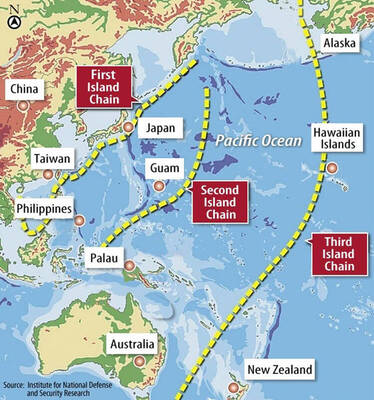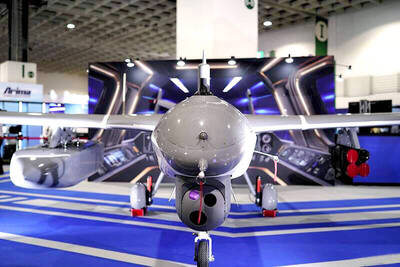South Korea will pull out all remaining workers from a jointly run industrial zone in North Korea, it said yesterday, after Pyongyang rejected a call for formal talks to end a standoff that led to operations being suspended.
The decision to remove about 170 people from the Kaesong factory park located just north of the armed border, deepens the conflict between the two Koreas and puts at risk their last remaining channel of exchange that resulted from their breakthrough 2000 summit and a bid to improve ties.
North Korea, angry at UN sanctions and joint South Korean-US military drills, has threatened both countries with nuclear attack in recent weeks.
“Because our nationals remaining in the Kaesong industrial zone are experiencing greater difficulties due to the North’s unjust actions, the government has come to the unavoidable decision to bring back all remaining personnel in order to protect their safety,” South Korean Unification Minister Ryoo Kihl-jae said.
The North withdrew its 53,000 workers from the complex this month amid spiralling tension between the two Koreas.
The North has prevented South Korean workers and supplies from getting into the zone since April 3.
North Korea rejected the proposal of talks, saying the South has acted in an “unpardonable” manner to jeopardize a “precious” legacy of the rivals’ bid to seek peace.
The North’s National Defense Commission, its supreme leadership body, repeated that what it saw as the reckless behavior of the South had thrown into question the safety of the zone’s operations.
The Kaesong project opened in 2004 as part of a so-called sunshine policy of engagement and optimism between the two Koreas, with 123 South Korean companies producing clothing, household goods and motorcycle helmets employing local workers.
The zone was a lucrative source of cash for the North, providing it with almost US$90 million a year. South Korean manufacturers have been paying about US$130 a month to North Korea for each of the workers they employ.
On Thursday, South Korea made the proposal for formal talks as the South Korean workers who remained at the zone were believed to be running out of food and other supplies. It had demanded an answer from the North by yesterday.
The number of South Koreans in the zone has dwindled from the 700 or so normally needed to keep the factories running to about 170, seen as the minimum number needed to safeguard assets at the 1 trillion won (US$894.73 million) park.
North Korea stepped up defiance of UN Security Council resolutions in December last year when it launched a rocket that it said had put a scientific satellite into orbit.
Critics said the launch was aimed at developing technology to deliver a nuclear warhead mounted on a long-range missile.
The North followed that in February with its third test of a nuclear weapon.
That brought new UN sanctions, which in turn led to a dramatic intensification of North Korea’s threats of nuclear strikes against South Korea and the US.

The US government has signed defense cooperation agreements with Japan and the Philippines to boost the deterrence capabilities of countries in the first island chain, a report by the National Security Bureau (NSB) showed. The main countries on the first island chain include the two nations and Taiwan. The bureau is to present the report at a meeting of the legislature’s Foreign Affairs and National Defense Committee tomorrow. The US military has deployed Typhon missile systems to Japan’s Yamaguchi Prefecture and Zambales province in the Philippines during their joint military exercises. It has also installed NMESIS anti-ship systems in Japan’s Okinawa

‘WIN-WIN’: The Philippines, and central and eastern European countries are important potential drone cooperation partners, Minister of Foreign Affairs Lin Chia-lung said Minister of Foreign Affairs Lin Chia-lung (林佳龍) in an interview published yesterday confirmed that there are joint ventures between Taiwan and Poland in the drone industry. Lin made the remark in an exclusive interview with the Chinese-language Liberty Times (the Taipei Times’ sister paper). The government-backed Taiwan Excellence Drone International Business Opportunities Alliance and the Polish Chamber of Unmanned Systems on Wednesday last week signed a memorandum of understanding in Poland to develop a “non-China” supply chain for drones and work together on key technologies. Asked if Taiwan prioritized Poland among central and eastern European countries in drone collaboration, Lin

NO CONFIDENCE MOTION? The premier said that being toppled by the legislature for defending the Constitution would be a democratic badge of honor for him Premier Cho Jung-tai (卓榮泰) yesterday announced that the Cabinet would not countersign the amendments to the local revenue-sharing law passed by the Legislative Yuan last month. Cho said the decision not to countersign the amendments to the Act Governing the Allocation of Government Revenues and Expenditures (財政收支劃分法) was made in accordance with the Constitution. “The decision aims to safeguard our Constitution,” he said. The Constitution stipulates the president shall, in accordance with law, promulgate laws and issue mandates with the countersignature of the head of the Executive Yuan, or with the countersignatures of both the head of the Executive Yuan and ministers or

CABINET APPROVAL: People seeking assisted reproduction must be assessed to determine whether they would be adequate parents, the planned changes say Proposed amendments to the Assisted Reproduction Act (人工生殖法) advanced yesterday by the Executive Yuan would grant married lesbian couples and single women access to legal assisted reproductive services. The proposed revisions are “based on the fundamental principle of respecting women’s reproductive autonomy,” Cabinet spokesperson Michelle Lee (李慧芝) quoted Vice Premier Cheng Li-chiun (鄭麗君), who presided over a Cabinet meeting earlier yesterday, as saying at the briefing. The draft amendment would be submitted to the legislature for review. The Ministry of Health and Welfare, which proposed the amendments, said that experts on children’s rights, gender equality, law and medicine attended cross-disciplinary meetings, adding that